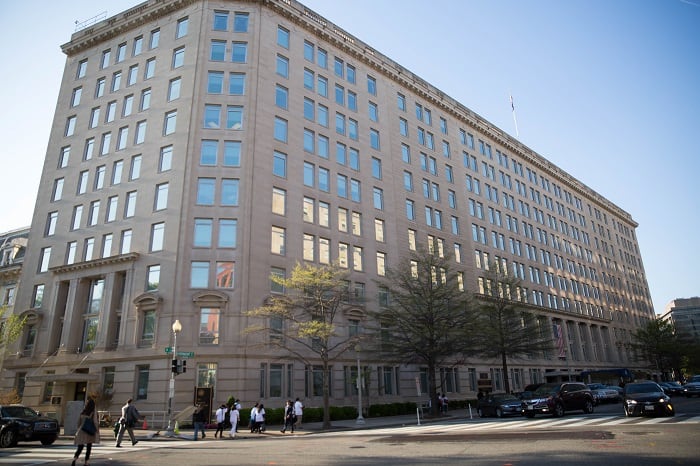When Marine Maj. Vince Coglianese was getting ready to leave his assignment in Hawaii, he and his wife, Mary, wanted to take their three boys on a trip they'd remember before packing up and moving to their new duty station in Florida.
"We had to go up to Kilauea and see the lava flows," he recalls. "We hiked right up to them. I jabbed our hiking stick into the lava and got a good char on it. You could feel the heat."
Some 14 years later, now Brig. Gen. Coglianese tells the story in his New Jersey drawl with a gleam in his eye. He and Mary still laugh as he jokes about nearly singeing all his hair off in the process.
Whatever memories the Coglianese boys carried with them, you can tell this is one of those family trips the couple will always cherish.
Some 1,500 active volcanoes dot the globe, sparking, simmering and smoking along the edges of the planet's 15 tectonic plates as they grind against each other to create all that heat.
But even the big crater-topped mountains that have stood dormant for centuries command a special respect, like a sleeping dragon of stone that might just wake up again.
That walking stick hangs in a place of honor above the mantel at the Coglianese family's home at Camp Pendleton, California, where Coglianese is the commander of the 1st Marine Logistics Group.
So get out your own walking sticks. Here are 10 of our favorite volcano adventures near military installations.
1. Kilauea
Hawaii
Hawaii's Mauna Loa is the largest volcano on the planet. Called "Long Mountain" in Hawaiian for good reason, it takes up about half of the state's Big Island. For more than a century, it was one of the region's most active volcanoes, with a regular display of fiery explosions.
But in 1984, Mauna Loa went silent. It has remained mostly inactive since. Luckily for lava lovers, nearby Kilauea, in the Big Island's southeast, began erupting the year before — and hasn't stopped.
Kilauea's deep, roiling lava lake is best viewed from Halema'uma'u Crater, part of Hawaii Volcanoes National Park, although lava flows regularly wind all the way down to the ocean from other vents.
What to do: Troops and their families have a base camp on the Big Island, which is a quick flight from the military hubs on Oahu. Kilauea Military Camp, a joint forces recreation center inside the national park, has cottages and apartments for military ID card-holders and veterans. Take guided day trips through the park and up to the lava flows of the volcano itself, as well as down into the fishing village of Hilo and its nearby waterfalls, parks and farmers market.
2. Mount Redoubt
Alaska
When Royal Navy explorer Captain James Cook first looked up at Mount Redoubt in the summer of 1778, he noted in his logbook that the 10,000-foot summit rim was "emitting a white smoke but no fire."
He had good reason to be concerned. Since 1900, it has erupted five times, most recently in 2009, when Joint Base Elmendorf-Richardson — about 100 miles away — was blanketed in a thin layer of volcanic ash.
While considered among the most dangerous on the planet, mostly because of its downwind proximity to Anchorage, Redoubt is just one of more than 130 volcanoes in Alaska. About 50 of them are considered active, many lining the inlet named after Cook.
What to do: Redoubt stands guard on the eastern edge of Lake Clark National Park, where outdoor-lovers enjoy backpacking, camping, fishing, photo hunting, kayaking and rafting.
But don't try to drive there. No roads lead in. Most visitors hop in from Anchorage by small plane.
If you don't want to rough it, the park is home to more than a dozen lodges, inns and bed-and-breakfasts, including Redoubt Mountain Lodge along the glacier-fed waters of Crescent Lake in the volcano's foothills. While visits aren't cheap — all-inclusive stays start at $1,345 per night — rates include round-trip float plane, guided fishing, kayaking, photography forays, and all meals and snacks.
3. Mount Rainier
Washington
Dominating the Seattle skyline, Mount Rainier is better known for its year-round snowline, with more than 35 square miles of glaciers dotting its flanks.
But deep below, a massive magma chamber — as much as 10 miles thick and just as wide — churns out toward nearby Joint Base Lewis-McChord.
Rainier's 14,410-foot cratered peak makes it the tallest volcano in the continental U.S.
A collision of fire and ice has shaped the mountain over the millennia, with lava flows channeling through massive glaciers. Mount Rainier National Park's Sunrise Visitor Center, just over 6,400 feet up the mountain, sits on top of one ancient lava ledge.
With the last eruption more than 100 years ago, Rainier is now known as an "active, but quiet" volcano. But mountaineers who trek to its summit see firsthand evidence of the mountain's molten roots as they climb past "steam vent" caves channeling up through the ice.
In fact, Rainier is far more active than previously believed, experts say. "We now understand there are risks associated with the volcano and its glaciers that require visitors and staff to be aware and prepared," warns the National Park Service.
What to do: All those glaciers make Mount Rainier a waterfall wonderland. Narada Falls, on the hairpin-turning drive up to the mountain's Paradise area, is worth a stop, with a footbridge spanning the gap just above the 200-foot plunge and a quick trail down to the cool spray-filled base of the falls.
The most famous of Washington State's five active vocanoes is Mount St. Helens — about a three-hour drive from Paradise. Mount St. Helens blew its top in 1980 with an explosive eruption that destroyed hundreds of homes and created an ash plume that stretched to Alberta, Canada.
4. Lassen Peak
California
While California may be known for its earthquakes, all that seismic activity has also created 20 volcanoes. From Mount Shasta in the north to the Coso Volcanic Field in the high desert of the south, five volcanoes are currently considered active.
But the state's most recent series of eruptions spewed from the 10,400-foot Lassen Peak. The explosive eruptions ravaged the local area about three hours north of Travis Air Force Base over three years before finally ending in 1917.
What to do: Lassen Volcanic National Park is home to all four major types of volcanoes. Meanwhile, steam and volcanic-gas vents dubbed "fumaroles," burping hot mud pots and boiling pools, are all heated by the molten rock still churning beneath Lassen Peak.
With park areas ranging from from Devils Kitchen and Bumbass Hell to Sulphur Works and Boiling Springs Lake, it's easy to see where settlers drew their inspiration.
But don't let the names fool you. With eight campgrounds and 150 miles of hiking trails, the park is a favorite for those who want Yosemite-like epic outdoor vistas without the Yosemite crowds.
5. Yellowstone Caldera
Wyoming
First thoughts of Yellowstone National Park typically turn to Old Faithful. But stop to consider what fuels that near-perfectly predictable geyser of boiling water, not to mention the other 300 geysers scattered around the park, among 10,000 geothermal hotspots ranging from boiling springs to bubbling mudpots to steaming fumaroles.
In fact, Yellowstone Caldera — aka Yellowstone Supervolcano — is so big, its 50-mile-wide caldera, or volcanic cavity, spans much of the park itself.
What to do: You could spend a life of summers exploring Yellowstone, but if you only have a day, Old Faithful is an awesome thing to experience. For overnight stays, Idaho's Mountain Home Air Force Base runs Flagg Ranch, just two miles from Yellowstone's South Entrance, with 26-foot trailer rentals at $80 per night. The base's Outdoor Recreation office offers tours and trips to Yellowstone.
6. Sunset Crater
Arizona
It's been 900 years since this volcano last spewed an 800-foot fountain of fire from the 1,000-foot-high cinder cone now known as Sunset Crater. After losing an arm as a Union artilleryman, geologist John Wesley Powell explored the region after the Civil War and is said to have given the volcano its modern name because its rim of red and yellow rock formations evokes the colors of a perpetual sunset.
Will it erupt anytime soon? "Probably not," reassures the National Park Service. "Activity in the surrounding San Francisco Volcanic Field has moved slowly during the past 6 million years. The next eruption, if one occurs, is likely to be somewhere to the east of Sunset Crater."
What to do: If you want to practice lunar landings, this is where the Apollo astronauts did it. These days, 3,000-acre Sunset Crater Volcano National Monument, just outside of Flagstaff, is a favorite gathering place for star gazers and lava flow trail hikers. The park's 34-mile scenic loop winds through the Ponderosa pine around the crater, dropping 2,000 feet into the red rocks and prehistoric pueblos of the Wupatki desert.
While hiking is off-limits to the lip of the crater, you can climb to the top of another cinder cone via the Lenox Crater Trail. The summit of nearby O'Leary Peak, a seven-mile hike, offers excellent views down into Sunset Crater.
7. Dotsero
Colorado
As you drive out of the Rocky Mountain ski mecca of Vail on I-70 toward Glenwood Springs, the highway cuts across a 4,000-year-old lava flow stretching down the mountain into the Eagle River.
One of only three known volcanoes in Colorado, Dotsero is the most recently active — erupting about 4,000 years ago — with a crater rim about half a mile wide and 1,300 feet deep.
What to do: About three hours from the military hub in Colorado Springs, Dotsero overlooks the confluence of the Eagle and Colorado rivers. It's a relatively easy hike up from the unnamed Bureau of Land Management road that snakes up from the highway past the crater rim.
"Adventurous hikers can pick their way down the slope of the crater to explore the bottom. However, this is not an easy trek and is not recommended for children," says avid Colorado hiker and online trail reviewer Deb Stanley.
"A BLM geologist told me to look for dark Basalt rocks, crack them open, and if there is something sparkling inside, it's likely a diamond," she reports in her online trailreview.
When you're done hiking, cool off with some lazy river tubing at Turtle Tubing.
For more trail bagging, Hanging Lake Trail in nearby Glenwood Springs is consistently rated one of the best day hikes in the state.
8. Jackson Volcano
Mississippi
Among the few eastern U.S. volcanoes is perhaps the most unusual — at least in terms of locale.
Less than 10 minutes outside the gate of Keesler Air Force Base, the city of Jackson is one of four towns in the U.S. that can lay claim to a volcano inside the city limits. If you've been stationed in the area, you may be wondering where it's hiding.
Step inside the Mississippi Coast Coliseum, and you're standing atop the spot where lava would explode from the volcano top — about 3,000 feet underground.
Rest easy, though. The last time that happened was about 70 million years ago.
What to do: While the volcano itself isn't a tourist magnet, Keesler's Outdoor Recreation and Marina office offers kayak rentals, guided Gulf Coast trips, sunset pontoon-boat cruises, deep-sea fishing trips and more. And, of course, there's whatever big event is happening at the Coliseum.
9. Mount Fuji
Japan
While considered active, the iconic symbol of Japan's natural beauty hasn't erupted since 1708.
A magnitude 6.2 earthquake in 2011 on the mountain's southern flank, as well as the major tsunami that same year, focused attention on Fuji's growing magma reservoirs, now believed by some experts to be creating more pressure than in 1708.
What to do: While Fuji is the tallest mountain in Japan, it's relatively easy to hike, with more than 250,000 people summiting annually along Fujiyoshida trail alone, mostly between July and early September.
10. Mount Etna, Sicily
Sicily
With thousands of residents of ancient Pompeii buried under more than 10 feet of ash, Italy's Mount Vesuvius gets all the press. But Sicily's Mount Etna is where the action is.
It's one of 13 active volcanoes dotting Italy, with lava constantly oozing down from its summit or being bottled up for a more explosive show of force.
Naval Air Station Sigonella sits just under Etna, and many stationed there live along its lower flanks.
What to do: It's a beautiful drive to the public observatory, where you'll pass through thick pine forests into the surreal black rock landscape that dominates the mountaintop.
In winter, there's nothing like skiing on an erupting volcano. For summer, hike along the lava flows in the morning, then hit the beach for some scuba diving in the afternoon.




